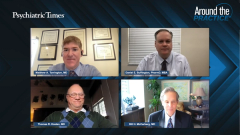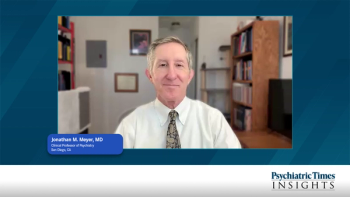
Using Naloxone Against Opioid Use
Our panel of doctors and pharmacists introduce naloxone, an opioid antagonist, as an option when treating opioid abuse or overdose.
Episodes in this series

Matthew A. Torrington, MD: That brings us to naloxone, which is an opioid antagonist. It has been widely used to counteract the effects of an opioid overdose. My story with naloxone starts in the mid-2000s, when I was writing prescriptions for that were illegal because I never saw the patients as part of the needle exchange. I was like, “Everybody needs to have naloxone around.” What we found when we studied patients who got naloxone was that they stopped injecting salt or water, or putting people in cold baths or running, or doing all the other crazy things that they used to do. [It’s because when] somebody had an overdose, nobody wanted to call 911. When they did, they were terrified. I want to springboard into your experience with naloxone. Where did it start? What’s your opinion, and what do you think about naloxone for overdose prevention?
Thomas R. Kosten, MD: Unfortunately, in my state most of the overdoses have fentanyl in them. This means 1 dose of your standard naloxone 0.4 mg given, say, intramuscularly or even 2 mg given intranasally is simply not going to be enough to override that overdose. They often have to give 2, 3, sometimes 4 doses of naloxone to override and bring them back. Now, in some of the littler towns, half their police department budget is buying naloxone. They’ve started to say that if it’s a third overdose for the same person, they won’t treat them because they can’t afford it. It’s astounding. It’s true that you’re going to need a much bigger dose. Some of the new products, like 8 mg intranasally, are probably going to become the standard because fentanyl is everywhere and there’s going to be a cost-effectiveness in all this. Dan can probably address the cost business. Giving 0.4 mg, even though it’s a generic, still comes to a lot of money. If you do it intranasally, well, there were the injectors for a while. But cost is not my specialty. Nonetheless, you need more naloxone.
Daniel E. Buffington, PharmD, MBA: Tom, there are data that absolutely support that. If you look from 2015 to 2020, and in the last 2 or 3 years, you can see that with the increased prevalence of a higher-potency fentanyl products creeping in, multiple studies have tracked the average number of administrations of naloxone in a standard form. If you look at the nasal, that would be 4. The percentage of time you’re having to do multiples—2, 3, 4, and in some studies, they’re tracking 5 administrations to reverse the effect—is absolutely a driver and a patient safety need. The times have changed based on what’s available and floating in the marketplace.
Bill H. McCarberg, MD: The FDA, AMA [American Medical Association], and CDC [Centers for Disease Control and Prevention] all requested a higher dose. They were pushing for that. We have new products that were recently approved in April and October 2021. The FDA approval process for that was not very stringent. They didn’t have double-blind placebo control trials, but they recognized that we need to get more. Imagine this from a patient perspective. [Let’s say] the patient has a box of Narcan at home. It’s got 2 doses. They give both doses because they don’t respond to the first 2. They don’t have any more at home. It’s not like you’ve got multiple boxes. The EMT [emergency medical technician] may have some, but the patient at home doesn’t have 1. Now you’ve got a death because you didn’t have an adequate dose, so it becomes even more important that we have a larger dose because of all these accumulated data and the organizations wanting a higher dose.
Daniel E. Buffington, PharmD, MBA: There’s another nuance. I absolutely agree that clinically and in point of care in the communities, we need greater amount of access. But there’s another nuance. When you look at practices that are prescribing naloxone simultaneously and educating patient and family and caregivers, there’s a decrease in the number of acute events, like a direct patient safety issue for the prescribed medications. If someone were to get access or utilize the medication illicitly or inappropriately, there’s a direct benefit of educating [their family] and having that at the patient’s home and people in the family knowing how to use that product. It’s a secondary deterrent, but it’s also a benefit of getting naloxone into the hands of families who have patients with that medication in the home.
Matthew A. Torrington, MD: That’s such a great point, Dan. People don’t realize that when they get fake pills from the black or gray market, they could kill them. The pills from the pharmacy would never have done that. When you furnish a prescription to naloxone, it’s a requirement in California for everyone who gets an opioid and a benzodiazepine, who has a history of overdose and other indications, that you at least offer them the prescription. You’re teaching them that overdose is possible. I always throw in, “Hey, the pills from the pharmacy are much less dangerous than anything you buy illicitly.” Whether they tell you it’s heroin or Vicodin or oxycodone, or roxicodone, it likely is powered by carfentanil, remifentanil, and acetyl fentanyl, and that stuff is incredibly dangerous. And if there’s an overdose, this is what you can do.
Matthew A. Torrington, MD: My analogy for naloxone is that it’s like a fire extinguisher or an AED [automated external defibrillator]. We see AEDs all the time. If you’ve ever had to use 1 in public, it’s not like you’re not going to call 911. Somebody just had a cardiac event. They’re not done after you put the AED on them. It’s the first step. If there’s a fire in your house, you may be able to use the fire extinguisher to help, but you’re not able to totally extinguish it. You’re still calling the fire department, and you may be calling them anyway. There are limitations to naloxone and what it can do, but it’s a very helpful tool and 1 that we should make sure patients have access to.
Bill H. McCarberg, MD: Matt, you have to emphasize to the family that the patient may wake up and look fairly normal in that interval. They aren’t aware of how dangerous that interval is. That’s when they need to call and go back and check on the patient 3 minutes later because the half-life of the Narcan—depending how it’s given—can be an hour or 2. But the effective half-life, how long it reverses the overdose, can be very short—4 or 5 minutes. You have enough time to call 911, but you’ve got to be back there. That’s what the patient needs to know. Often, there’s a reluctance on the patient’s part to have 911 called when they’re awake because it could be a cost, stigma—“Now everybody is going to know I overdosed”—a lot of things. But you’ve got to emphasize to the family that if you don’t call 911, your loved one may die and here’s why.
This transcript has been edited for clarity.
Newsletter
Receive trusted psychiatric news, expert analysis, and clinical insights — subscribe today to support your practice and your patients.













